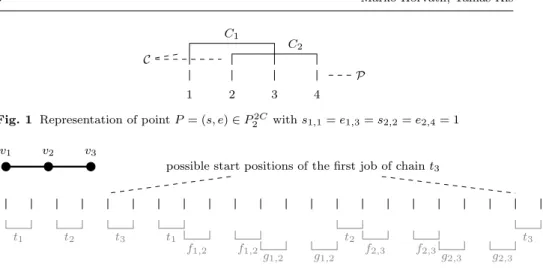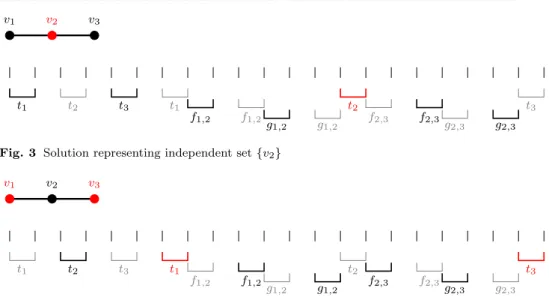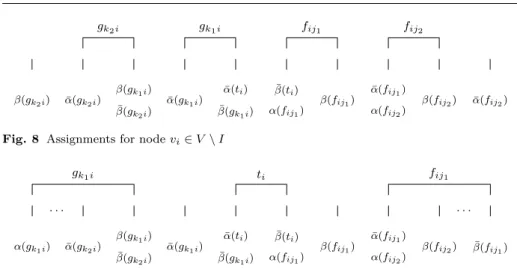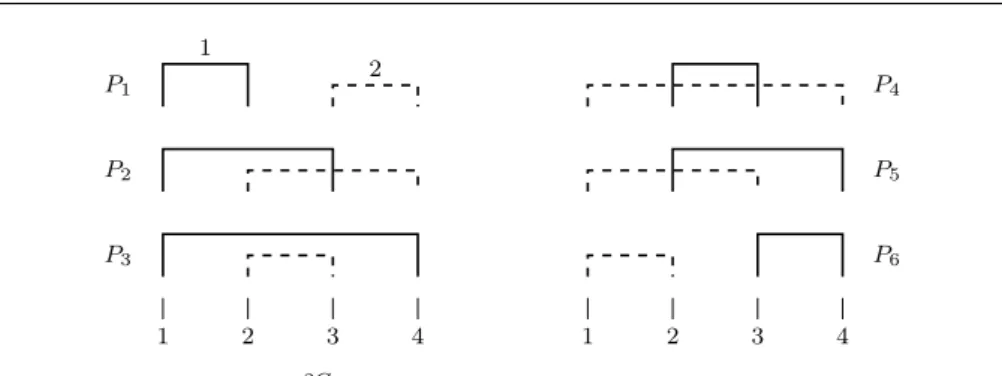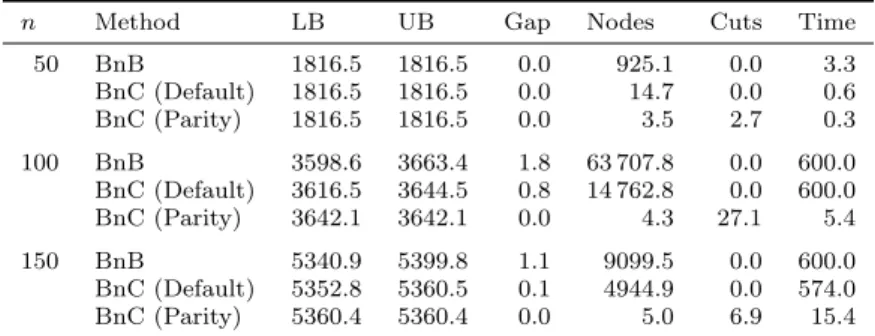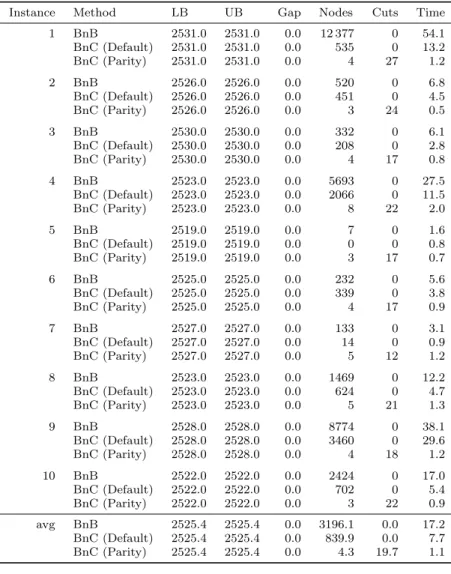(will be inserted by the editor)
Polyhedral results for position based scheduling of chains on a single machine
Mark´o Horv´ath · Tam´as Kis
Received: date / Accepted: date
Abstract We consider a scheduling problem where a set of unit-time jobs have to be sequenced on a single machine without any idle times between the jobs.
Preemption of processing is not allowed. The processing cost of a job is determined by the position in the sequence, i.e., for each job and each position, there is an associated weight, and one has to determine a sequence of jobs which minimizes the total weight incurred by the positions of the jobs. In addition, the ordering of the jobs must satisfy the given chain precedence constraints. In this paper we investigate the polyhedron associated with a special case of the problem where each chain has length two. We show that optimizing over this polyhedron is strongly NP-hard, however, we present a class of facet-defining inequalities along with a polynomial-time separation procedure. We generalize these results to the case of chains with lengths at most two. Finally, we present our computational results that show that separating these inequalities can significantly improve a linear programming based branch-and-bound procedure to solve the problem.
Keywords scheduling·polyhedra·cutting planes
This work has been supported by the OTKA grant K112881, and by the grant GINOP-2.3.2- 15-2016-00002 of the Ministry of National Economy of Hungary.
Mark´o Horv´ath
Institute for Computer Science and Control, Hungarian Academy of Sciences, H1111 Budapest, Kende str. 13–17, Hungary
ORCID: 0000-0002-1062-6272 Tam´as Kis
Institute for Computer Science and Control, Hungarian Academy of Sciences, H1111 Budapest, Kende str. 13–17, Hungary
Tel.: +36-1-279-6156 Fax: +36-1-466-7503
E-mail: tamas.kis@sztaki.mta.hu ORCID: 0000-0002-2759-1264
1 Introduction
We consider a scheduling problem where a set of unit-time jobs have to be se- quenced on a single machine without any idle times between the jobs. Preemption of processing is not allowed. The ordering of the jobs must satisfy a given prece- dence relation derived from a directed acyclic graph. The processing cost of a job is determined by the position in the sequence, i.e., for each job and each position, there is an associated weight (which can be any rational number), and one has to determine a sequence of jobs which minimizes the total weight incurred by the positions of the jobs. In the following we consider the case of chain precedence constraints with chain-lengths at most two, that is, each job has at most one im- mediate predecessor and at most one immediate successor, and each chain consists of at most two jobs.
Formally, letJ ={J1, . . . , Jn}be the set of unit-time jobs, that is, each jobJj
has processing timepj = 1. For a given scheduleS and jobJj let σSj ∈ {1, . . . , n}
indicating the position of the job in the sequence (that is,σjS=kif exactlyk−1 jobs are scheduled beforeJj). For each jobJj and positionkgiven a weightwj,k∈Q, thus the weight of jobJj for a given scheduleS iswj,σS
j. The goal of the problem is to determine a schedule S that minimizes the total weight Pn
j=1wj,σS j. Using the classification of deterministic sequencing and scheduling problems introduced by Graham et al. (1979) we denote the problem as 1|pj = 1|P
wj,σj. In the case of precedence relations we have a directed acyclic graph where the nodes correspond to the jobs, and if there is an arc between nodesiandj, then jobJimust be processed before job Jj. This problem is denoted as 1|prec, pj = 1|P
wj,σj, and if the directed acyclic graph decomposes into chains, then the problem is 1|chains, pj = 1|P
wj,σj. Note that problem 1|pj = 1|P
wj,σj is equivalent to the well-known assignment problem (Kuhn, 1955), thus the problem 1|prec, pj= 1|P
wj,σj can be considered as a generalized assignment problem where the set of positions is ordered, and the assignment must satisfy the given precedence constraints.
In this paper we investigate the polyhedra associated with special cases of the problem 1|chains, pj = 1|P
wj,σj. First, we consider the case where each chain has length two (i.e., the precedence graph is a directed perfect matching), that is, each node has either in-degree exactly one or out-degree exactly one. We denote this problem as 1|2-chains, pj = 1|P
wj,σj, where expression 2-chains indicates that each chain has length two, that is, consists of exactly two jobs. Then, we generalize the results of this problem to the case where the precedence constraints consist of chains with length at most two. The associated constraint is denoted by chains, chain-length∈ {1,2}.
The purpose of the paper at hand is to investigate the polyhedral structure of problems of the form 1|chains, pj= 1|γ. In Section 3 we give an integer program- ming formulation for the problem 1|prec, pj= 1| ◦(i.e, we consider feasibility, but neglect the optimality criterion), then in Section 4.1 we simplify it to the prob- lem 1|2-chains, pj = 1| ◦. In Section 4.2 we show that optimizing over the set of feasible solutions is NP-hard in the strong sense by showing that the problem 1|2-chains, pj = 1|P
wj,σj is strongly NP-hard. Note that the latter result implies that the problem 1|prec, pj = 1|P
wj,σj is NP-hard in the strong sense even in the case of chain precedence constraints with chain-lengths at most two. In Sec-
tion 4.3 we determine the dimension of the polyhedron of the feasible solutions of 1|2-chains, pj = 1| ◦. In Section 4.4 we present a class of valid inequalities for the given formulation, we prove that these inequalities are facet-defining, and we show that they can be separated in polynomial time. In Section 5 we generalize these inequalities for the problem 1|chains, chain-length ∈ {1,2}, pj = 1|γ. Fi- nally, in Section 6 we present our computational experiments, where we show that separating our inequalities can significantly improve a linear programming based branch-and-bound procedure to solve the problems 1|2-chains, pj = 1|P
wj,σj
and 1|chains, chain-length∈ {1,2}, pj= 1|P wj,σj. 2 Literature Review
Lenstra and Rinnooy Kan (1980) and Leung and Young (1990) present complexity results for scheduling unit-time jobs on a single machine with chain precedence constraints, i.e., problems of the form 1|chains, pj = 1|γ. Clearly, the problems with γ=Cmax andγ=P
wjCj are polynomially solvable. Lenstra and Rinnooy Kan (1980) and Leung and Young (1990) show that problems with γ = P
Uj
andγ=P
Tj are NP-hard, respectively. Our results in this paper imply that the problem withγ=P
wj,σj is NP-hard in the strong sense even if each chain in the precedence relation has length 2.
Wan and Qi (2010) introduce new scheduling models where time slot costs have to be taken into consideration. In their models the planning horizon is divided into K ≥Pn
j=1pj time slots with unit length, where thekth time slot has cost πk, and the time slot cost of a job Jj with starting time t is P
k∈sjπk, where sj = {t+ 1, . . . , t+pj}. The objective of their models is a combination of the total time slot cost with a traditional scheduling criterion, that is, they consider problems of the form 1|slotcost|γ+P
j
P
k∈sjπk. Wan and Qi (2010) show that in case of non-decreasing time slot costs (that is,π1≤. . .≤πK) the problem can be reduced to one without slot costs. Under the assumption of arbitrarily varied time slot costs they prove that the problems withγ=P
Cj,γ=Lmax,γ=Tmax,
γ = P
Uj and γ = P
Tj are strongly NP-hard. They also show that in case of non-increasing time slot costs some of these problems can be solved in polynomial or pseudo-polynomial time. Zhao et al. (2016) prove that in case of non-increasing time slot costs, the problem 1|slotcost|P
(Cj+P
k∈sjπk) is NP-hard in the strong sense. Kulkarni and Munagala (2012) introduce a model similar to that of (Wan and Qi, 2010), however, they deal with online algorithms to minimize the total time slot costs plus the total weighted completion time. Note that the problem investigated in this paper can be considered as a generalization of a special case of the model of Wan and Qi (2010). That is, in case of unit-time jobs (with K=Pn
j=1pj=n) the problem 1|slotcost, pj = 1|P
j
P
k∈sjπk is similar to that of 1|pj= 1|P
wj,σj, however, in the latter problem the time slot costs depend on the jobs.
3 Problem formulation
Recall thatJ = {J1, . . . , Jn} is the set of unit-time jobs, and letP ={1, . . . , n}
be the set of positions. Let D= (V, A) be the directed acyclic precedence graph
with node set V = {1, . . . , n}. The presence of a directed i–j path in D implies that jobJi have to be assigned to an earlier position than jobJj (that is, jobJi
is a predecessor of jobJj, and jobJj is a successor of jobJi). LetJi ≺≺Jj (or equivalentlyi≺≺j) denote ifJi is a predecessor of jobJj. In addition, letJi≺Jj if jobJi is an immediate predecessor of jobJj, that is,Ji≺≺Jj, but there is no jobJk such thatJi≺≺Jk ≺≺Jj.
Let xi,j be the binary variable indicating whether job Ji is assigned to posi- tionj. The problem 1|prec, pj= 1| ◦can be formulated as
n
X
j=1
xi,j= 1, i∈ {1, . . . , n}, (1)
n
X
i=1
xi,j= 1, j∈ {1, . . . , n}, (2)
k+1
X
j=1
xi2,j ≤
k
X
j=1
xi1,j, i1≺i2, k∈ {1, . . . , n−1}, (3) xi,j∈ {0,1}, i∈ {1, . . . , n}, j∈ {1, . . . , n}, (4) where constraints (1) and (2) model the job-position assignment constraints, and constraint (3) ensures that the precedence constraints are satisfied. Let Ji+ = {Ji0 ∈ J : Ji ≺≺ Ji0} (Ji− = {Ji0 ∈ J : Ji0 ≺≺ Ji}) be the set of successors (predecessors) of job Ji. Clearly, for each feasible solution x ∈ {0,1}n·n of the problem (1)–(4) we have
xi,j= 0, i∈ {1, . . . , n}, j∈ {1, . . . ,|Ji−|}, (5) xi,j= 0, i∈ {1, . . . , n}, j∈ {n− |Ji+|+ 1, . . . , n}. (6) In case of problem 1|prec, pj= 1|P
wj,σj for given weightsw:J × P →Qthe optimality criterion can be formulated as
minimize
n
X
i=1 n
X
j=1
wi,jxi,j.
4 Problem 1|2-chains, pj = 1|γ
In this section we investigate the problem 1|2-chains, pj= 1|γ. Recall that in this problem the set of jobs has even cardinality, and each job has either exactly one predecessor or exactly one successor. In Section 4.1 we reformulate the problem described in the previous section, and define the setQ2C of its feasible solutions.
In Section 4.2 we show that optimizing overQ2C, i.e., the problem 1|2-chains, pj= 1|P
wj,σj, is strongly NP-hard. In Section 4.3 we determine the dimension of the polytopeQ2C. In Section 4.4 we present a class of valid inequalities forQ2C that are facet-defining, and we also provide a polynomial time algorithm for separating these inequalities. For basic concepts of polyhedral combinatorics we refer the reader to (Nemhauser and Wolsey, 1988).
4.1 Problem formulation
In order to simplify our notation, in this section letJ ={J1, . . . , J2n}be the set of unit-time jobs, andC={C1, . . . , Cn}be the set of chain-precedence constraints, where Ci = (J2i−1, J2i), that is, J2i−1 ≺J2i for eachi∈ {1, . . . , n}. We say that jobJ2i−1(J2i) is the first (second) job of chainCi. In addition, letP={1, . . . ,2n}
be the set of positions.
Letsi,j (ei,j) indicate whether the first (second) job of chainCi∈ C is assigned to positionj∈ P. Using these variables we reformulate (1)–(6) as:
2n
X
j=1
si,j= 1, i∈ {1, . . . , n}, (7)
2n
X
j=1
ei,j= 1, i∈ {1, . . . , n}, (8)
si,2n= 0, i∈ {1, . . . , n}, (9)
ei,1= 0, i∈ {1, . . . , n}, (10)
n
X
i=1
si,1= 1, (11)
n
X
i=1
(si,j+ei,j) = 1, j∈ {2, . . . ,2n−1}, (12)
n
X
i=1
ei,2n= 1, (13)
k+1
X
j=1
ei,j≤
k
X
j=1
si,j, i∈ {1, . . . , n}, k∈ {1, . . . ,2n−2}. (14)
Constraints (7)–(8) and (11)–(13) are the job-position assignment constraints (see (1) and (2)). Constraints (9)–(10) ensure that each first-job precedes the corresponding second-job (see (3)). Finally, constraints (9)–(10) forbid to assign a first-job to the last, or a second-job to the first position (see (5)–(6)).
LetPn2C⊆ {0,1}n·(2n)× {0,1}n·(2n)be the set of incidence vectors correspond- ing to feasible job-position assignments, and let Q2nC= conv(Pn2C). By construc- tion, we have the following proposition.
Proposition 1 Pn2C={(s, e)∈ {0,1}n·2n× {0,1}n·2n: (s, e)satisfies(7)−(14)}.
For a given point P = (s, e) ∈ Pn2C, let s(P, i) = j (e(P, i) = j) if si,j = 1 (ei,j= 1). For a giveni∈ {1, . . . , n}letσi(P) be a 2-dimensional vector such that σi(P) = (s(P, i), e(P, i)), andσ(P) be a 2n-dimensional vector such that σ(P) = (σ1(P), . . . , σn(P)). For example, for the point P indicated in Figure 1 we have P = (1,0,0,0, 0,1,0,0, 0,0,1,0, 0,0,0,1), σ1(P) = (1,3), σ2(P) = (2,4), and σ(P) = (1,3,2,4).
1 2 3 4 C1
C2
C
P
Fig. 1 Representation of pointP = (s, e)∈P22C withs1,1=e1,3=s2,2=e2,4= 1 v1 v2 v3
t1 t2 t3 t1 t2 t3
f1,2 f1,2
g1,2 g1,2 f2,3 f2,3
g2,3 g2,3
possible start positions of the first job of chaint3
Fig. 2 Construction for the 2-length path
4.2 Optimizing overQ2nC
In Theorem 1 we will show that optimizing over the polyhedron Q2nC is NP-hard in the strong sense. We will transform theIndependent Set(IS) problem to prob- lem (15). An instance of IS is given by an undirected graphG= (V, E) with node set V ={v1, . . . , vn}, and a maximum size subset of nodes I ⊆V is sought such that for each edge{u, v} ∈E,|{u, v} ∩I| ≤1. The basic idea of the transformation can be seen in Figure 2, where we depict the construction for the 2-length path.
Briefly stated, we will create a chainti for each node vi and two chainsfi,j and gi,j for each edge{vi, vj}of the IS instance, and some additional dummy chains.
To each of these chains we will designate two potential start and two potential end positions. On the one hand, by determining appropriate weights we will force that in each solution with non-negative total weight, each of these chains either starts/ends at its first start/end position, or at its second start/end position. In Figure 2 we depict the two potential states of these chains. On the other hand, by designating these positions properly, we will force that each solution with non- negative total weight represents an independent set in the IS instance and vice versa. Namely, a node is in the independent set if and only if the corresponding chain starts/ends its second start/end position. For example, in Figure 3 we depict the solution that represents the independent set{v2}(without the dummy chains).
Note that since chaint2starts/ends at its second start/end position, i.e.,v2 is in the independent set, thus chains g1,2, f1,2 and therefore t1 should start/end at its first start/end position, i.e.,v1 cannot be in the independent set. Similarly,t3
cannot start/end at its second start/end position, that is,v3 cannot be in the in- dependent set. In Figure 4 we depict the solution that represents the independent set{v1, v3}(without the dummy chains).
Theorem 1 Letws, we:{1, . . . , n} × {1, . . . ,2n} →Rbe arbitrary weight functions.
The problem
maximize
n
X
i=1 2n
X
j=1
ws(i, j)si,j+
n
X
i=1 2n
X
j=1
we(i, j)ei,j: (s, e)∈Pn2C
(15)
v1 v2 v3
t2 t1 t3
f1,2 g1,2 f2,3 g2,3
t1 t3
f1,2 g1,2 f2,3 g2,3
t2
Fig. 3 Solution representing independent set{v2}
v1 v2 v3
t2
f1,2
g1,2
f2,3
g2,3
t2
t1 t3
f1,2
g1,2
f2,3
g2,3
t1 t3
Fig. 4 Solution representing independent set{v1, v3}
is NP-hard in the strong sense.
Proof We transform the Independent Set (IS) problem to problem (15). Let G = (V, E) be an instance for the independent set problem with node set V = {v1, . . . , vn}, and let −→E = {(vi, vj) : {vi, vj} ∈ E, i < j} be the set of directed edges, i.e., we replace undirected edge {vi, vj}by directed edge (vi, vj) fori < j. For a node vi let succ(i) ={vj : (vi, vj) ∈ −→
E} (pred(i) = {vj : (vj, vi)∈ −→ E}) denote its immediate successors (predecessors).
For each vi ∈V we create a node-chain ti, and for each edge (vi, vj)∈−→ E we create edge-chains fi,j and gi,j. Let TV = {ti : vi ∈ V} and T−→
E = {fi,j, gi,j : (vi, vj)∈ −→
E}. To each node-chain ti ∈ TV we designate four distinct positions:
α(t1)
1
β(t1)
2
α(tn)
2n−1
β(tn)
2n
¯ α(t1)
2n+ 1
β(t¯ 1)
2n+ 2
¯
α(t2) β(t¯ 2) α(t¯ n) β(t¯ n)
· · · · · · · · ·
Fig. 5 Designated positions for node-chains
α(ti)< β(ti)<α¯(ti)<β¯(ti) such that
i) 2i−1 =α(ti) =β(ti)−1, for alli∈ {1, . . . , n}, ii) 2n+ 1 = ¯α(t1) = ¯β(t1)−1,
iii) ¯β(ti)<α¯(ti+1) = ¯β(ti+1)−1, for alli∈ {1, . . . , n−1}, see Figure 5. To each edge-chain fi,j ∈ T→−
E we designate four distinct positions:
α(fi,j) < β(fi,j)< α¯(fi,j) <β¯(fi,j). Consider a node vi ∈ V and its immediate successors succ(i) ={vj1, . . . , vj|succ(i)|}. Let
iv) α(fi,j1) = ¯β(ti),
v) α(fi,j`) =β(fi,j`)−1 = ¯α(fi,j`)−2, for all`∈ {1, . . . ,|succ(i)|},
vi
vj1
vj2
vj3
¯ α(ti)
β(t¯ i)
α(fij1) β(fij1)
¯ α(fij1) α(fij2) β(fij2)
¯ α(fij2)
α(fij3) β(fij3) ¯α(fij3) ¯β(fij1) ¯β(fij2) ¯β(fij3) ¯α(ti+1)
· · · Fig. 6 Designated positions for edge-chains (part 1)
vj
vi1
vi2
vi3 α(t¯ j)
β(t¯ j) β(gi1j)
¯ α(gi1j)
β(g¯ i1j) β(gi2j)
¯ α(gi2j)
β(g¯ i2j) β(gi3j) ¯α(gi3j)
β(g¯ i3j) β(f¯ i1j)
α(gi1j) β(f¯ i2j) α(gi2j)
β(f¯ i3j) α(gi3j)
· · · · · · · · ·
Fig. 7 Designated positions for edge-chains (part 2)
vi) ¯α(fi,j`) =α(fi,j`+1), for all`∈ {1, . . . ,|succ(i)| −1},
vii) ¯α(fi,j|succ(i)|) = ¯β(fi,j1)−1 = ¯β(fi,j2)−2 =. . .= ¯β(fi,j|succ(i)|)− |succ(i)|, viii) ¯β(fi,j|succ(i)|)<α¯(ti+1),
see Figure 6. Finally, to each edge-chain gi,j ∈ T−→E we designate four distinct positions: α(gi,j) < β(gi,j)< α¯(gi,j) < β¯(gi,j). Consider a node vj ∈ V and its immediate predecessors pred(j) ={vi1, . . . , vi|pred(j)|}. Let
ix) ¯β(gi1,j) = ¯α(tj),
x) β(gi`,j) = ¯α(gi`,j)−1 = ¯β(gi`,j)−2, for all`∈ {1, . . . ,|pred(j)|}, xi) β(gi`,j) = ¯β(gi`+1,j), for all `∈ {1, . . . ,|pred(j)| −1},
xii) α(gi`,j) = ¯β(fi`,j), for all`∈ {1, . . . ,|pred(j)|}, xiii) ¯β(tj−1)< β(gi1,|pred(j)|),
see Figure 7.
For each vi ∈V we have created 1 chain and designated 4 positions, and for each (vi, vj)∈−→
E we have created 2 chains and designated 8 positions, however, positionsα(fi,j), ¯β(gi,j) and ¯β(fi,j) coincide with other positions (see iv), vi), ix), xi), and xii)), hence we have|V|+ 2|E|chains, and 4|V|+ 5|E|distinct positions.
Thus, we also create|V|+|E|dummy chains and|E|dummy positions, therefore we have 2|V|+ 3|E|chains and 2×(2|V|+ 3|E|) positions, that is, we have a valid instance for problem (15).
Let M > n. For eachti∈ TV let
ws(ti, j) =
−M ifj=α(ti), 0 ifj= ¯α(ti),
−2M otherwise,
and we(ti, j) =
M ifj=β(ti), 1 ifj= ¯β(ti),
−2M otherwise. For eachti,j∈ T→−E (ti,jis either fi,j orgi,j) let
ws(ti,j, j) =
−M ifj=α(ti,j), 0 ifj= ¯α(ti,j),
−2M otherwise,
and we(ti,j, j) =
M ifj=β(ti,j), 0 ifj= ¯β(ti,j),
−2M otherwise. Finally, let ws(t, j) = we(t, j) = 0, for each dummy chains t and for all j = 1, . . . ,(4|V|+ 6|E|).
¯
α(ti) β(t¯ i)
α(fij1) β(fij1)
¯ α(fij1)
α(fij2) β(fij2) α(f¯ ij2) β(g¯ k1i)
β(gk2i) α(g¯ k2i)
β(g¯ k2i) β(gk1i)
¯ α(gk1i)
fij1 fij2
gk1i
gk2i
Fig. 8 Assignments for nodevi∈V \I
¯
α(ti) β(t¯ i) α(fij1)
β(fij1) α(f¯ ij1) α(fij2)
β(fij2) β(f¯ ij1) β(g¯ k1i)
α(gk1i) α(g¯ k2i)
β(g¯ k2i) β(gk1i)
¯ α(gk1i)
ti fij1
gk1i
· · ·
· · ·
Fig. 9 Assignments for nodevi∈I
Remark 1 By construction, in any feasible solution for the constructed problem, for eacht∈ TV we have
X
j
ws(t, j) +X
j
we(t, j) =
0 ifst,α(t)=et,β(t)= 1, 1 ifst,α¯(t)=et,β¯(t)= 1,
≤ −M+ 1 otherwise, and for eacht∈ T−→
E we have X
j
ws(t, j) +X
j
we(t, j) =
0 ifst,α(t)=et,β(t)= 1 orst,α¯(t)=et,β¯(t)= 1,
≤ −M otherwise.
Thus a solution for the created problem has non-negative total weight if and only if each chaint∈ TV∪ T→−E starts/ends either its first start/end or its second start/end position.
Proposition 2 LetI⊆V an independent set. There is a solution for the constructed problem with total weight|I|.
Proof Ifvi∈/I, then letsti,α(ti)=eti,β(ti)= 1, for each (vi, vj)∈−→
E letsfij,α(fij)= efij,β(fij)= 1, and for each (vk, vi)∈−→
E let sgki,α¯(gki) =eg
ki,β¯(gki) = 1 (see Fig- ure 8). Otherwise, ifvi∈I, then letsti,α¯(ti)=et
i,β¯(ti)= 1, for each (vi, vj)∈−→ E let sfij,α¯(fij)=ef
ij,β¯(fij)= 1, and for each (vk, vi)∈−→
E letsgki,α(gki)=egki,β(gki)= 1 (see Figure 9). The variables for dummy chains can be arbitrary fixed.
On the one hand, we claim that this assignment yields a feasible solution. We need to show, that each position that designated to multiple jobs is assigned to a single job. It is easy to check that it is true for positions α(fi,j) and ¯β(gi,j). We also know, that ¯β(fi,j) = α(gi,j) for all edge (vi, vj)∈ −→
E (see xii)), however, we assigned position ¯β(fi,j) to jobfi,j and positionα(gi,j) to job gi,j if and only if vi∈Iandvj∈I, respectively, however it is impossible, sinceIis independent. On the other hand, it is clear that the weight of the solution is equal to|I|. ut
Proposition 3 Consider a solution to the constructed problem with non-negative total weightW. There is an independent setI⊆V with|I|=W.
Proof Since W is non-negative, according to Remark 1, for eacht∈ TV ∪ T−→E we have eitherst,α(t)=et,β(t)= 1 orst,α¯(t)=et,β¯(t)= 1. We claim that the node set I={vi∈V : sti,α¯(ti)=et
i,β¯(ti)= 1}is independent.
Suppose for a contradiction that there is an edge (vi, vj)∈−→
E such thatvi, vj∈ I. Letsucc(i) ={vj1, . . . , vj|succ(i)|}be the set of the immediate successors of node vi. Sinceeti,β¯(ti)= 1 and by construction ¯β(ti) =α(fij1), thussfij1,α(fij1)= 0 and therefore sfij1,α¯(fij1)=ef
ij1,β¯(fij1)= 1. Again, by construction ¯α(fij1) =α(fij2), thussfij2,α(fij2)= 0 and thereforesfij2,α¯(fij2)=ef
ij2,β¯(fij2)= 1. Similarly, we can show thatsf
ij`,α¯(fij`)=ef
ij`,β¯(fi,j`)= 1 holds for all`= 1, . . . ,|succ(i)|, moreover, sincej=j`for some`∈ {1, . . . ,|succ(i)|}we haveef
ij,β¯(fij)= 1.
Let pred(j) ={vi1, . . . , vi|pred(j)|} be the set of the immediate predecessors of node vj. Similarly, we can show that sg
i`j,α(gi`j) = eg
i`j,β(gi`j) = 1 holds for all ` = 1, . . . ,|pred(j)|, and since i = i` for some ` ∈ {1, . . . ,|pred(j)|} we have sgij,α(gij)= 1.
To sum up, we have ef
ij,β¯(fij) =sgij,α(gij) = 1 which yields a contradiction, since by construction ¯β(fij) =α(gij). ut Finally, it is easy to see that our transformation is a pseudo-polynomial transfor- mation, thus the problem is NP-hard in the strong sense. ut Note that multiplying each weight value by -1 yields that the minimization version is also strongly NP-hard.
Corollary 1 The problem1|2-chains, pj= 1|P
wj,σj is strongly NP-hard.
Corollary 2 The problem1|chains, pj= 1|P
wj,σj is strongly NP-hard even in the case of chains with length at most 2.
Corollary 3 The problem1|prec, pj= 1|P
wj,σj is strongly NP-hard.
4.3 Dimension ofQ2nC
In this section we investigate the dimension of the polyhedronQ2nC. Theorem 2
dim(Q2nC) =
0ifn= 1, 5ifn= 2, 4n2−6n+ 1ifn≥3.
Sketch of the proof of Theorem 2 (n≥3) We will show (see Theorem 3 and Proposi- tion 6) that a minimal equation system forQ2nChas rank 6n−1, thus the dimension ofQ2nC is 4n2−(6n−1).
Theorem 3 Letn≥3. The equation system{(7)−(13)}contains a minimal equation system forQ2nC.
Proof We show that any equation which holds for all points of Q2nC is a linear combination of the equations (7)–(13). Assume that
n
X
i=1 2n
X
j=1
αi,jsi,j+
n
X
i=1 2n
X
j=1
βi,jei,j=γ (16)
holds for all (s, e)∈Q2nC. In order to show that equation (16) is a linear combi- nation of equations (7)–(13) we explicitly create a linear combination (17), and in Propositions 4 and 5 we prove that (16) and (17) are the same. In these proposition we use Lemma 1, however, for its proofs we refer to the appendix.
Lemma 1 For equation (16) the following statements hold:
i) αp,j00−αp,j0=βq,j00−βq,j0 ∀p, q∈ {1, . . . , n}, 1< j0 < j00<2n, ii) αp,j00−αp,j0=αq,j00−αq,j0 ∀p, q∈ {1, . . . , n}, 1≤j0< j00<2n, iii) βp,j00−βp,j0 =βq,j00−βq,j0 ∀p, q∈ {1, . . . , n}, 1< j0< j00≤2n.
Note that in case of i)pmay be equal toq.
Consider the linear combination of equations (7)–(13) with coefficientsλ7i,λ8i, λ9i,λ10i ,λ11,λ12j ,λ13 (i∈ {1, . . . , n},j∈ {2, . . . ,2n−1}), respectively, where
• λ7i =αi,1−α1,1 for alli∈ {1, . . . , n},
• λ8i =βi,2n−β1,2n+β1,2−α1,2for alli∈ {1, . . . , n},
• λ9i =αi,2n−αi,1+α1,1 for alli∈ {1, . . . , n},
• λ10i =βi,1−βi,2n+β1,2n−β1,2+α1,2for alli∈ {1, . . . , n},
• λ11=α1,1,
• λ12j =α1,j for allj∈ {2, . . . ,2n−1},
• λ13=β1,2n−β1,2+α1,2.
Let n
X
i=1 2n
X
j=1
ˆ αi,jsi,j+
n
X
i=1 2n
X
j=1
βˆi,jei,j= ˆγ (17)
be the resulted equation. Note that the left-hand side can be written as
n
X
i=1
(λ7i+λ11)si,1+ (λ7i +λ9i)si,2n+ (λ8i +λ10i )ei,1+ (λ8i+λ13)ei,2n
+
+
n
X
i=1 2n−1
X
j=2
(λ7i +λ12j )si,j+ (λ8i +λ12j )ei,j .
Proposition 4 For linear combination (17) the following statement holds:
I) αˆi,j=αi,j for alli∈ {1, . . . , n}andj∈ {1, . . . ,2n}.
Proof Let i∈ {1, . . . , n}be fixed. For j= 1 we have ˆ
αi,1=λ7i +λ11= (αi,1−α1,1) +α1,1=αi,1, and forj= 2n we have
ˆ
αi,2n=λ7i +λ9i = (αi,1−α1,1) + (αi,2n−αi,1+α1,1) =αi,2n.
For a givenj∈ {2, . . . ,2n−1}we have ˆ
αi,j=λ7i +λ12j = (αi,1−α1,1) +α1,j ii=)αi,j,
where for the last equation we use statement ii) of Lemma 1 withp = 1,q = i,
j0= 1 andj00=j. ut
Proposition 5 For linear combination (17) the following statement holds:
II) βˆi,j=βi,j for alli∈ {1, . . . , n}andj∈ {1, . . . ,2n}.
Proof Let i∈ {1, . . . , n}be fixed. For j= 1 we have
βˆi,1=λ8i+λ10i = (βi,2n−β1,2n+β1,2−α1,2)+(βi,1−βi,2n+β1,2n−β1,2+α1,2) =βi,1, and forj= 2n we have
βˆ1,2n=λ8i +λ13= (βi,2n−β1,2n+β1,2−α1,2) + (β1,2n−β1,2+α1,2) =βi,2n. For a givenj∈ {2, . . . ,2n−1}we have
βˆi,j=λ8i +λ12j = (βi,2n−β1,2n+β1,2−α1,2) +α1,jiii=)βi,2−α1,2+α1,j=i)βi,j. since βi,2n−β1,2n +β1,2 = βi,2 according to statement iii) of Lemma 1, and βi,2−α1,2+α1,j =βi,j due to statement i) of Lemma 1. ut Corollary 4 Linear combination (17) yields equation (16).
Proof According to Proposition 4 and 5, the left-hand sides of (17) and (16) are the same. Since both of them are satisfied by the points from the non-empty setPn2C,
the right-hand sides also coincide. ut
u t Proposition 6 Letn≥3. The rank of the equation system{(7)−(13)}is6n−1. Proof Consider a linear combination of equations (7)–(13) with coefficientsλ7i,λ8i, λ9i,λ10i ,λ11,λ12j ,λ13 (i∈ {1, . . . , n},j∈ {2, . . . ,2n−1}), respectively. This linear combination can be written as
n
X
i=1
(λ7i+λ11)si,1+ (λ7i +λ9i)si,2n+ (λ8i +λ10i )ei,1+ (λ8i +λ13)ei,2n
+
+
n
X
i=1 2n−1
X
j=2
(λ7i +λ12j )si,j+ (λ8i+λ12j )ei,j
=λ11+λ13+
n
X
i=1
λ7i +λ8i
+
2n
X
j=1
λ12j .
It is the zero-equation (i.e., both of the right-hand side and the coefficients of the equation are zero) if and only if λ9i = −λ7i = λ11, λ7i = −λ12j = λ8i and λ10i = −λ8i = λ13 hold for all i ∈ {1, . . . , n}, j ∈ {2, . . . ,2n−1} and the right- hand side is zero. On the one hand, it is clear that we can easily choose non-zero coefficients that yield the zero-equation, thus the equations are linearly dependent.
On the other hand, if we omit a single equation from (7)–(13), that is, we fix a single coefficient fromλ7i, . . . , λ13to zero, then all the remaining coefficients will be zero, that is, that remaining equations are linearly independent. Thus the equation system{(7)−(13)}containing 6nequations has rank 6n−1. ut
1 2 P1
P2
P3
1 2 3 4
P4
P5
P6
1 2 3 4
Fig. 10 The six points ofP22C
Proof (Theorem 2)In case ofn= 1,P12C consists of a single pointP with σ(P) = (1,2), thus dim(Q2nC) = 0.
In case of n = 2, P22C = {P1, . . . , P6}, where σ(P1) = (1,2,3,4), σ(P2) = (1,3,2,4), σ(P3) = (1,4,2,3), σ(P4) = (2,3,1,4), σ(P5) = (2,4,1,3), σ(P6) = (3,4,1,2), see Figure 10. The linear combination of these points with coefficientsλ1, . . . , λ6, respectively, is
(λ1+λ2+λ3)s1,1+ (λ4+λ5)s1,2+λ6s1,3+ (λ4+λ5+λ6)s2,1+ (λ2+λ3)s2,2+ +λ1s2,3+λ1e1,2+ (λ2+λ4)e1,3+ (λ3+λ5+λ6)e1,4+λ6e2,2+ +(λ3+λ5)e2,3+ (λ1+λ2+λ4)e2,4. Clearly, we get the zero-vector if and only ifλ1= 0,λ6= 0 andλ2=−λ3=λ5=
−λ4. On the one hand, we can easily choose non-zeroλ2, . . . , λ5 coefficients to get the zero-vector, thus points P1, . . . , P6 are dependent. On the other hand, if we omit for example P2, i.e., we fix λ2= 0, we could get the zero-vector if and only ifλ1 =. . .=λ6 = 0, that is, pointsP1, P3, P4, P5, P6 are independent. Therefore dim(P22C) = 5.
Finally, assume that n≥3. Clearly, all points from Q2nC satisfy the equations (7)–(13). According to Theorem 3, (7)–(13) contains a minimal equation system for Q2nC, thus according to Proposition 6, the rank of such a minimal equation system is 6n−1. We have 4n2 variables, thus dim(Q2nC) = 4n2−(6n−1). ut
4.4 Parity inequalities
Theorem 4 Letn≥2. The following inequalities are valid forQ2nC: X
i∈S 2k
X
j=1
(si,j−ei,j)≤ |S| −1 +X
i /∈S 2k
X
j=1
(si,j−ei,j)
∀S⊆ {1, . . . , n}:|S|is odd, k < n, (18)
X
i∈S 2k−1
X
j=1
(si,j−ei,j)≤ |S| −1 +X
i /∈S 2k−1
X
j=1
(si,j−ei,j)
∀S⊆ {1, . . . , n}:|S|is even, k≤n. (19)
